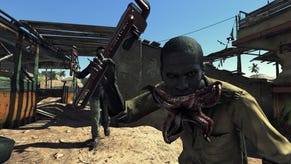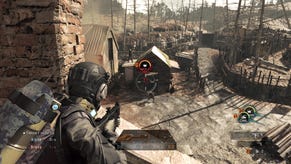Resident: Evil Umbrella Corps is more than a half-arsed attempt to jump on the FPS bandwagon
The next Resident Evil game is a multiplayer shooter - here's four big reasons to give it some of your time.
Resident Evil is a franchise out of its time. The things that seem so wonderful in your fuzzy pink memories fail to shift units in modern games, and attempts to update the series for a broad audience have not been received joyfully by fans or critics.
Goodness knows what the publisher is going to do with the core series in the face of this dilemma, but in the meantime there's Resident Evil: Umbrella Corps. Announced at Tokyo Game Show 2015 to cries of "didn't we learn anything from Operation Racoon City?", Umbrella Corps differs from its precursor in being an in-house Capcom project and also by turning up with several very interesting core ideas that have the potential to offer a very different kind of experience.
Historically I've not been interested in competitive shooters. I think Resident Evil is something of a joke in the year 2015. I am deeply cynical about everything Capcom does. And yet: I played a bit of Umbrella Corps at TGS 2015 and also had a chat with producers Masachika Kawata and James Vance, and I came away kind of, uh, you know - kind of into it? Let me tell you why.
The zombies and zombie jammer
I asked Kawata why Umbrella Corps had to be a Resident Evil game and he was kind of like 'the zombies, obviously'. The zombies really lend an interesting element to gameplay. For one thing, they fill your radar with activity; you have no idea where your enemies might be, disguised as they are by the undead's signals, unless they start a proper firefight.
You can leverage this, killing off a few zombies to hopefully lure someone into a trap, but the shambling horrors really come into their own when things go pear shaped. You see, every operative is equipped with a zombie jammer which masks their scent or aura or whatever it is zombies use to differentiate a living human from another of their kind, and if it is damaged in a fight, they'll swarm. Pop off an enemy's jammer (they're especially vulnerable while crawling) and they'll have to shoot their way through endless waves of zombies as they try to find you in the mess.
The deceptive radar means you can use zombies to mask your movements, too, which is especially important as Umbrella Corps is less run-and-gun and more sneak-and-wreak-havoc.
An emphasis on stealth and tactics
We only got to play one map and one mode at TGS 2015, but that one was a doozy: a 3v3, one life elimination affair in a claustrophobic, multi-levelled map.
Recently there's been a trend towards agility in shooters (think Titanfall, Destiny, Advanced Warfare) and this has opened up a great deal of verticality in map design. You can't double jump in Umbrella Corps as far as I could tell, and there was no room to - the map we played on was tight, made up of corridors and small rooms, air vents, hatches and stairwells.
Instead, crouching and crawling were the alternate movement modes of choice, as it reduced your chances of being spotted - while, of course, restricting your own view. Paths and choke points seemed far smaller than is usual in video games - much more on the human scale - and I have rarely felt so aware of the inherent danger of my surroundings. At any moment an enemy could appear. It was terrifying.
This strongly encouraged careful, tactical play - perfect for a fireteam of three, with two on point for crossfire and one watching the six. Creeping through corridors and popping headshots on unwary foes spotted over partitions was immensely satisfying, as was ghosting out from under or behind something to lay in with a shotgun. Capcom's very proud of its analogue cover system, which lends an organic element to stealth not found with AI opponents.
Capcom assured us there will be lots of different game modes, but even free-for-alls on larger maps are going to lend themselves to smart play, thanks to the game's other unique features. To whit:
The shield
As with most shooters, headshots are extremely deadly in Umbrella Corps. Unlike most shooters, there's something you can do about it; if you use a one-handed weapon, such as a handgun or the melee Brainer, your character raises their other hand in front of their face, blocking headshots with a wrist-mounted tactical shield. You can see the shield in the screenshot above - it's the red panel on the left arm.
Say your enemy is using a slow-firing, precise weapon, relying on deadly criticals to pick off foes from a distance. You can just block your head and run forward while they fruitlessly ping you with body shots, arriving in their face to dismember them with your Brainer, or peppering them with headshots of your own as you charge. That's going to stir things up among snipers and campers.
The shield is super interesting gameplay-wise, but seemed kind of silly to me until Kawata told me it was inspired by the armguards used to train attack dogs. Of course if you were going up against enemies whose primary attack is to bite, you'd have some way to defend yourself against them. That's where the shield idea came from: zombies.
This has a tactical use, too. If you aggro a zombie into attacking you (they will fight back if you damage them) you can get them to bite your shield. You can then tramp merrily about with their body hanging from your raised arm, which acts both as a helpful shield against incoming fire and something of a disguise - it might not stand up to close inspection but it will deceive a momentary glance. Sometimes, that's all the time you need.
The Brainer
Finally, there's the primary melee weapon - the Brainer. When you're using this bad boy you have the advantage of the headshot-blocking shield, but that's not the end of its powers. Its standard hit is devastatingly hard, but it also can be charged up for an even more powerful hit, making you more likely to win the little duels that occur if two Brainers strike at exactly the same time.
They're also silent and can kill in one hit; vitally important in a game so supportive of stealth and teamwork. If Brainers have one weakness, it's that they can be blocked with shields and become stuck - an embarrassing situation and one that's hard to recover from.
That's not the end of what Umbrella Corps has to offer. Capcom isn't ready to talk about player and faction progression yet, but I got the feeling there's plenty to come - especially as Capcom did say there'll be lots of room for character customisation.
I'm sure in that regard Capcom will try to offer a package rivalling those of popular multiplayer shooters with online progression, but what really interests and impresses me is that in so many other ways it's not trying to compete with the Call of Duty crowd. Resident Evil: Umbrella Corps is an intriguing project on its own merits. What a refreshing prospect.














